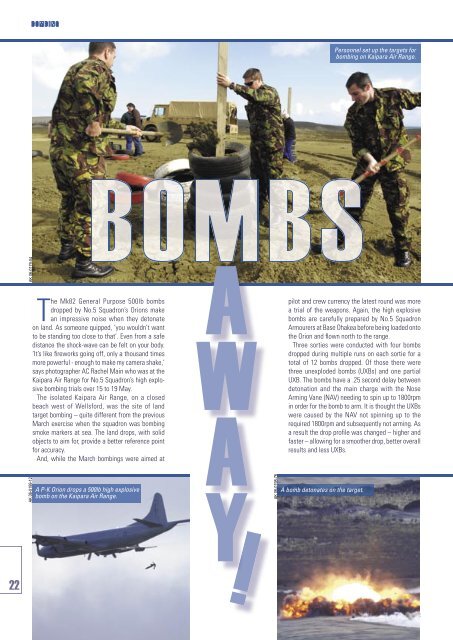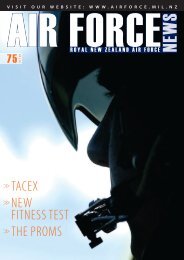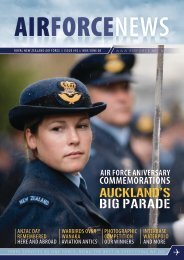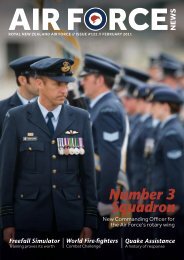June 2006, Issue 71 [pdf 2.8mb, 40 - Royal New Zealand Air Force
June 2006, Issue 71 [pdf 2.8mb, 40 - Royal New Zealand Air Force
June 2006, Issue 71 [pdf 2.8mb, 40 - Royal New Zealand Air Force
Create successful ePaper yourself
Turn your PDF publications into a flip-book with our unique Google optimized e-Paper software.
22<br />
AK 06-0199-12 AK 06-0179-04<br />
The Mk82 General Purpose 500lb bombs<br />
dropped by No.5 Squadron’s Orions make<br />
an impressive noise when they detonate<br />
on land. As someone quipped, ‘you wouldn’t want<br />
to be standing too close to that’. Even from a safe<br />
distance the shock-wave can be felt on your body.<br />
‘It’s like fi reworks going off, only a thousand times<br />
more powerful - enough to make my camera shake,’<br />
says photographer AC Rachel Main who was at the<br />
Kaipara <strong>Air</strong> Range for No.5 Squadron’s high explosive<br />
bombing trials over 15 to 19 May.<br />
The isolated Kaipara <strong>Air</strong> Range, on a closed<br />
beach west of Wellsford, was the site of land<br />
target bombing – quite different from the previous<br />
March exercise when the squadron was bombing<br />
smoke markers at sea. The land drops, with solid<br />
objects to aim for, provide a better reference point<br />
for accuracy.<br />
And, while the March bombings were aimed at<br />
A P-K Orion drops a 500lb high explosive<br />
bomb on the Kaipara <strong>Air</strong> Range.<br />
A<br />
W AY<br />
!!!<br />
AK 06-0198-76<br />
pilot and crew currency the latest round was more<br />
a trial of the weapons. Again, the high explosive<br />
bombs are carefully prepared by No.5 Squadron<br />
Armourers at Base Ohakea before being loaded onto<br />
the Orion and fl own north to the range.<br />
Three sorties were conducted with four bombs<br />
dropped during multiple runs on each sortie for a<br />
total of 12 bombs dropped. Of those there were<br />
three unexploded bombs (UXBs) and one partial<br />
UXB. The bombs have a .25 second delay between<br />
detonation and the main charge with the Nose<br />
Arming Vane (NAV) needing to spin up to 1800rpm<br />
in order for the bomb to arm. It is thought the UXBs<br />
were caused by the NAV not spinning up to the<br />
required 1800rpm and subsequently not arming. As<br />
a result the drop profi le was changed – higher and<br />
faster – allowing for a smoother drop, better overall<br />
results and less UXBs.<br />
A bomb detonates on the target.<br />
Personnel set up the targets for<br />
bombing on Kaipara <strong>Air</strong> Range.<br />
AFN<strong>71</strong> JUNE 06 www.airforce.mil.nz



![February 2007, Issue 78 [pdf 3mb, 44 pages] - Royal New Zealand ...](https://img.yumpu.com/17485296/1/184x260/february-2007-issue-78-pdf-3mb-44-pages-royal-new-zealand-.jpg?quality=85)












